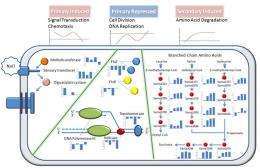Microbe provides clues about how cells respond to environmental change

Because they can respond quickly to environmental stress, the bacteria Shewanella are useful models for studying response to environmental change.
To gain needed insight about the sequence of mechanisms involved in the microbe’s rapid response, a multi-institutional team of researchers recently used a liquid chromatography mass spectrometry proteomics approach to study the time-course response of Shewanella amazonensis SB2B to sodium chloride (NaCl) stress. Although typically found in marine environments, Shewanella have been detected in environments ranging from fresh water to hypersaline conditions. Environmental fluctuations in the salinity of its native habitat suggest that S. amazonensis SB2B has evolved to deal with the effects of salt toxicity and hyperosmolarity effectively.
The team used its novel proteomics approach to gain new understanding about the sequence of events and coordination of mechanisms involved in salt tolerance such as initial signal transduction and regulation, turgor maintenance, motility, and metabolism. The researchers discovered that although sodium chloride stress is associated with a change in the membrane fatty acid composition in other organisms, this is not the case for SB2B because fatty acid degradation pathways were not expressed, and no change in the fatty acid profile was observed. These findings suggest that shifts in membrane composition may be an indirect physiological response to high NaCl stress. Understanding how these marine microbes respond provides new insight about the affects of environmental change and the strategies that these organisms have evolved to deal with these changes.
More information: Parnell JJ, et al. 2011. “Time-course Analysis of the Shewanella amazonensis SB2B Proteome in Response to Sodium Chloride Shock.” Scientific Reports 1:25, DOI: 10.1038/srep00025
Provided by Environmental Molecular Sciences Laboratory

















